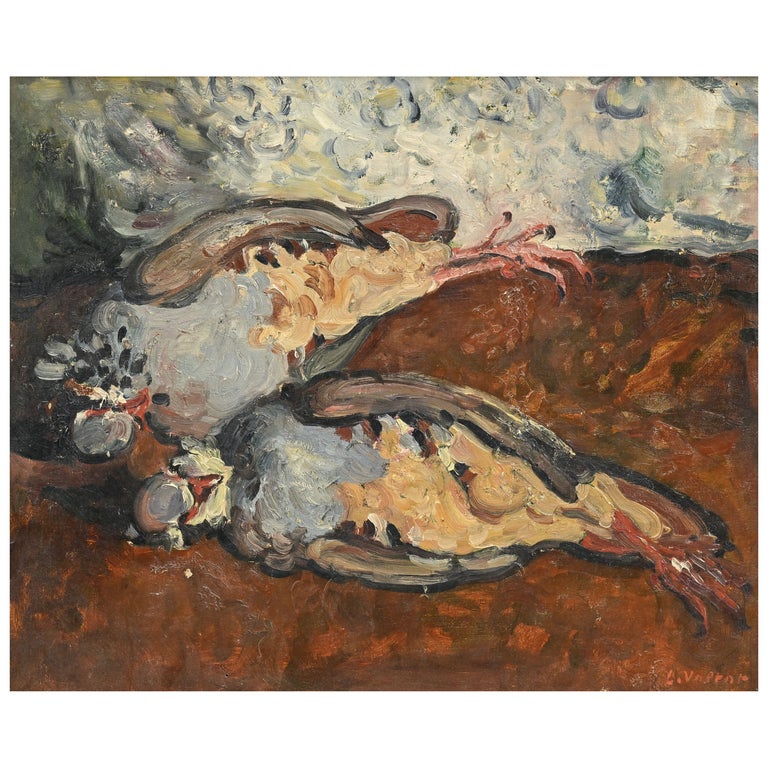Description
Louis Valtat (1869-1952), Nature morte aux pigeons
Oil on canvas, huile sur toile,
Signed: L Valtat LR, Signée: L Valtat
Canvas: 15.15 x 18.1 Inches (38,5×46 cm)
Framed: 25 x 28 Inches
Exposition and Literature:
Louis Valtat Rétrospective Centenaire : Louis Valtat (1869-1969), Petit Palais, Genève, 26 juin au 21 septembre 1969
Published by Petit Palais, 1969
Note: Original Catalogue will be included and accompany the sale of this painting.
Provenance: Georges Couturat, Paris, c.1930, Has been preserved by family for almost 100 years until March 2024. (puis restée dans la famille jusqu’à ce jour)
Piguet Hotel Des Ventes: Vette de Mars 2024 Tableaux. Geneva Switzerland
GEORGES COUTURAT COLLECTION (1890-1948)
A great merchant, patron and collector of the first part of the 20th century, Georges Couturat was a friend of painters. Grand-uncle of the current Swiss owners by marriage of a Vaudois patrician family, he worked to promote the work of modern artists such as Manguin, Camoin, Cross, Signac, Renoir, Pissarro, Valtat, etc… He built up an extraordinary collection of several hundred of works in his Parisian apartment including one of Caillebotte’s masterpieces, The Man on the Balcony. As an aesthete, he did not hesitate to provide advice to artists during their creative processes. More than an advisor for some, his relationship with Manguin could be compared to that of a confidant, comforting the latter in his moments of doubt, he helped him to establish his own painting. All the works from this collection have been preserved by descent in the family to this day.
Condition: Very good original condition with tight canvas and no in painting detected with blue light. Frame appears to be original to painting in age with wear, repairs and touch ups. Presents beautifully.
Louis Valtat (French: [valta]; 8 August 1869 – 2 January 1952) was a French painter and printmaker associated with the Fauves (“the wild beasts”, so named for their wild use of color), who first exhibited together in 1905 at the Salon d’Automne. He is noted as a key figure in the stylistic transition in painting from Monet to Matisse.
Louis Valtat was born on 8 August 1869 in Dieppe, in the Normandy region of France, into a wealthy family of ship owners. Valtat spent many of his childhood years in Versailles, a suburb of Paris, where he attended secondary school at the Lycée Hoche (near the Palace of Versailles). Encouraged by his father, an amateur landscape painter himself, Valtat became interested in art. At age 17, deciding to pursue an artistic career, he applied to the École des Beaux-Arts de Paris. He was accepted, and in 1887 Valtat moved to Paris to enroll at the Ecole, where he studied with the well-known academic artists Gustave Boulanger (1824–1888), Jules Lefebvre (1836–1911), and later with Jean-Joseph Benjamin-Constant (1845–1902).
Valtat subsequently studied at the Académie Julian (Julian Academy) under Jules Dupré (1811–1889), a landscape painter of the Barbizon school. Among his fellow students were Albert André (1869–1954), who became a close friend, as well as Maurice Denis (1870–1943), Pierre Bonnard (1867–1947), and Édouard Vuillard (1868–1940). These last three, calling themselves “Nabis” (after the Hebrew word meaning prophets), were influenced by Paul Gauguin’s (1848–1903) Synthetist method of painting based on the use of simple forms, pure colors, and large patterns. While Valtat remained detached from that movement, he learned from them.
In 1890, upon winning the Jauvin d’Attainville prize, Valtat established his own studio at rue La Glaciere in Paris. He made his debut in 1893 at the Salon of Independent Artists, displaying several paintings depicting street scenes of the neighborhood surrounding his art studio. One of those paintings, titled Sur Le Boulevard (On The Boulevard, 1893) was noted by the art critic Félix Fénéon. During this early period in his career, Valtat used the spontaneous light touches of Impressionism (although with bordered objects) and the colorful dots found in Pointillism. Two examples representing Valtat’s work during this period include Péniches (Barges, 1892) and the Pommiers (The Apple Trees, 1894). As noted by Cogniat, Péniches has the impressionistic rendering of the mobile reflections of rippling water while Pommiers is “alive with the dazzling brilliance of sunlit reds and yellows intensified by the stippled strokes of green”.
Valtat exhibited widely during his career. In 1894, he collaborated with both Henri de Toulouse-Lautrec and Albert André in creating the decor for the Paris theater “L’Œuvre” at the request of Lugné Poë.
Valtat suffered from tuberculosis, and he spent many autumn/winter seasons along the Mediterranean coast in Banyuls, Antheor and Saint-Tropez. Beginning in 1900, Valtat made several journeys by bicycle to visit Auguste Renoir at the Maison de la Poste in Cagnes. There, Valtat made several portrait drawings of Renoir on which he based a subsequent woodcut, and the two artists collaborated on a sculpture of Cézanne. Another friend of Valtat was Paul Signac, whom he visited often, traveling in a small Bollée motorcar that he acquired ca. 1904 from Signac in exchange for his painting Women at the Seashore. During his time spent near the Mediterranean, Valtat intensified his use of color and began to express his Fauvist tendencies, particularly in painting seascapes. Art historian Natalie Henderson Lee identifies Valtat as a “proto-Fauve”, although he remained somewhat apart from the Fauve group, and never adopted their extreme boldness in the treatment of form and color.
AVANTIQUES is dedicated to providing an exclusive curated collection of Fine Arts, Paintings, Bronzes, Asian treasures, Art Glass and Antiques. Our inventory represents time-tested investment quality items with everlasting decorative beauty. We look forward to your business and appreciate any reasonable offers. All of our curated items are vetted and guaranteed authentic and as described. Avantiques only deals in original antiques and never reproductions. We stand behind our treasures with a full money back return policy if the items are not as described.






